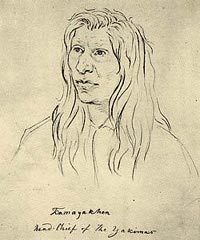Chief Kamiakin facts for kids
Quick facts for kids
Kamiakin
|
|
|---|---|

Drawing by Gustav Sohon (1855). Credit: Washington State Historical Society
|
|
| Born |
Kamiakin: "He won't go"
1800 near Starbuck, Washington
|
| Died | 1877 Rock Lake, Washington
|
| Occupation | Tribal leader |
| Known for | Leading resistance against encroaching settlers |
Kamiakin (born 1800, died 1877) was a very important leader of the Yakama, Palouse, and Klickitat peoples. These tribes lived east of the Cascade Mountains in what is now southeastern Washington state. In 1855, Kamiakin became worried when the governor of the Washington Territory, Isaac Stevens, threatened the tribes of the Columbia Plateau. Governor Stevens wanted to take their lands.
After being forced to sign a treaty that gave away tribal lands, Kamiakin decided to act. He brought together 14 other tribes and their leaders. Together, they fought in the Yakima War, which lasted from 1855 to 1858. After the war, Kamiakin had to escape to British Columbia and Montana. He returned to his home in 1860. In 1864, he moved to his father's old lands near Rock Lake in Whitman County, Washington, where he lived until he died.
Contents
Early Life of Kamiakin
Kamiakin had a mixed family background. His family included people from the Nez Perce, Spokane, and Yakama tribes. His father, Ki-yi-yah, had a Nez Perce father and a Spokane mother. Kamiakin's own mother was Yakama.
In 1825, Kamiakin married Sal-kow, who was also Yakama. Her father, Te-i-as, and grandfather, Weowikt, were important leaders in their tribe. Kamiakin later married another Yakama woman named Colestah.
The Yakama War
In 1855, Isaac Stevens became the new governor of the Washington Territory. He wanted to take land from the Native American tribes. He planned to sell this land to European American settlers. These settlers would then develop the land in ways the government approved. Governor Stevens threatened to remove the Native Americans by force if they did not sell their lands. He thought the best way was to gather many tribes and make them sign treaties.
Kamiakin, a strong leader of the Yakama, immediately started to organize. He made alliances with other important leaders. These included Peo-peo-mox-mox of the Walla Walla and Allalimya Takanin of the Nez Perce. Kamiakin eventually formed a large alliance with 14 tribes living on the Columbia plateau. All the leaders agreed that they wanted to stop American settlers and government officials from taking their lands. The fighting that followed is known as the Yakima Indian War of 1855.
The Walla Walla Council
In 1855, Kamiakin called a meeting in Eastern Oregon. Representatives from all the tribes in the Grande Ronde Valley came. They met to discuss how to deal with the settlers and keep their lands. Governor Stevens found out about this meeting. A Nez Perce leader named Lawyer told him what the tribes had decided.
Later, at the Walla Walla Council, Kamiakin arrived and saw many Nez Perce people and U.S. Government officials. He realized that his plans had been shared with the governor. Governor Stevens had used this information to get support for creating reservations among the tribes. When Oregon's Superintendent of Indian Affairs asked Kamiakin to speak, he proudly refused. However, other chiefs eventually convinced Kamiakin to sign the treaty "as an act of peace." This treaty created the Yakama reservation.
Battles and Defeat
Kamiakin led his warriors into the first battle of the war. On October 4 and 5, 1855, he defeated 84 soldiers led by Major Haller near Simcoe Valley. Kamiakin was also a key figure in the final battle of the war. On September 5, 1858, Colonel George Wright, with 700 soldiers, defeated Kamiakin and his warriors at the Battle of Four Lakes. Kamiakin was hurt in this battle when a pine tree, hit by cannon fire, fell on him.
It is said that Colestah, Kamiakin's wife, saved him from being captured by the U.S. soldiers. In the end, Kamiakin was the only leader who refused to give up. He escaped to Kootenai, British Columbia. From there, he went to Montana, where he lived with the Flathead tribe.
Kamiakin's Final Years
In 1860, Kamiakin returned to his home near the Palouse River. After his wife Colestah died in 1864, he moved to his father's old lands near Rock Lake (Washington) in Washington. Ranchers, led by William Henderson, tried many times to force Kamiakin off his family's land. However, Robert Milroy, who was the superintendent of Indian Affairs, stepped in. He kept his promise to let Kamiakin live out his days there peacefully.
The day before he died in 1877, Kamiakin was baptized as a Catholic and given the name "Matthew." A year after his death, his son, Tesh Palouse Ka-mi-akin, followed his people's customs. He opened his father's grave and wrapped his remains in a new blanket. Later, Kamiakin's body was moved to be reburied elsewhere. What was left of his remains was laid to rest at Nespelem, Washington, a village he had helped to start.
Places Named After Kamiakin
Kamiakin is remembered in many places in Washington state. At least five schools are named after him:
- Chief Kamiakin Elementary School in Sunnyside
- Kamiakin High School in Kennewick
- Kamiakin Junior High in Kirkland
- Kamiak High School in Mukilteo
- Kamiak Elementary in Pullman, Washington
Also, Kamiak Butte and Kamiakin's Gardens are named for him. Kamiakin's Gardens is listed on the National Register of Historic Places. There is also a street called Kamiakin Trl on Fairchild AFB.
See also
 In Spanish: Kamiakin para niños
In Spanish: Kamiakin para niños

